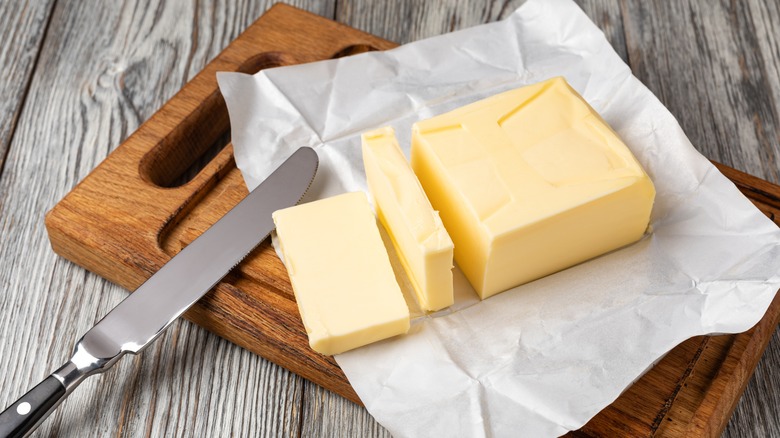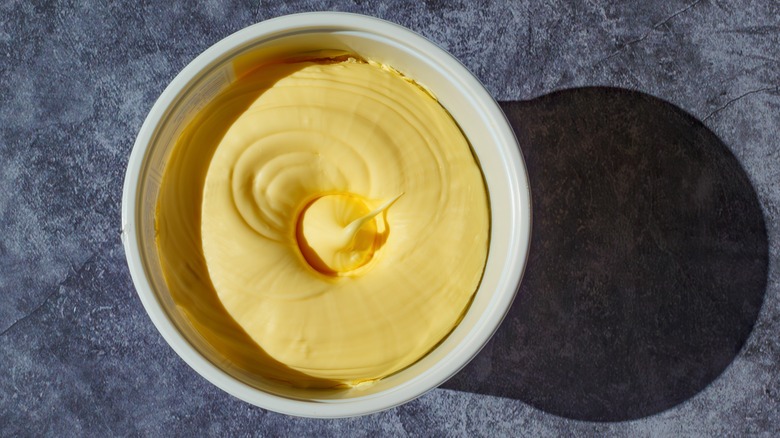What's The Difference Between Butter And Margarine?
Fats are an indispensable part of cooking and eating. From their vital medical qualities — like providing energy, supporting brain health, and regulating cholesterol — to their essential culinary features, such as adding flavor or lubricating a pan for heating, these compounds offer varied benefits. Given their importance, grocery stores naturally stock an extensive selection of fat varieties. Among these options, the subtle differences between butter and margarine can feel especially confusing.
After all, both look thick and spreadable, come with lightly creamy flavors, and are stable at room temperature. They're often grouped together at the grocery store, and their uses frequently overlap with some (but not complete) interchangeability. The primary distinction lies in their fat composition: Butter is derived from milk fat, while margarine is typically made from a blend of vegetable oils.
Yet, a closer investigation of their nuances reveals the true complexity of cooking fats. Their distinct plant- versus animal-based fat compositions lead to differing concentrations of water and varying melting points. The mouthfeel and flavor also diverge, as do their characteristics after heating — particularly when baking. So rather than simply grabbing a package, consider the minutiae, as there's a lot to unspread.
Butter offers a richer composition
Butter is an old and reliable fat source, with culinary use dating back thousands of years. This long history has led to a comprehensive breadth of creation processes, with different kinds of butter relying on varying milk types, fat percentages, optional fermentation, and regional techniques.
In the U.S., regulation mandates that butter must be composed of at least 80% milk fat. While "margarine" shares this overall fat percentage, it typically contains very little to no milk fat — usually capping out at 3% when present. This makes butter a distinctly dairy-forward product. As a result, the quality of the cream is a key factor in butter's final taste, often differentiating the best and worst store-bought butter brands. Generally, butter tends to offer a more decadent flavor and mouthfeel than margarine.
Furthermore, butter's dairy fat composition significantly influences its culinary qualities. Although it typically has a lower melting point than many margarines, butter maintains its solid state more readily at room temperature. And once heated, margarine turns more watery, which can lead to a weaker structure in baked goods. While this higher water content can impart tenderness in some specific recipes, butter's rigidity is often crucial for tasks like holding together cookies, creating thick frostings, and achieving flaky all-purpose pie crusts. Ultimately, butter's full-fat qualities come with rich benefits — not to mention often contributing to a richer, more delicious bite.
Margarine presents a versatile, blended fat alternative
Unlike butter's naturally occurring origins, margarine's history dates back to 1869, conceived as an industrial strategy to reduce costs. Initially, it used beef tallow as its primary fat source. Today, however, margarine is essentially an emulsified spread primarily made from vegetable oils. To transform typically liquid fats into a more solid form, these oils undergo chemical alteration and are then blended with water, stabilizers, and sometimes small amounts of dairy or other fats.
Because it's based on vegetable oils, margarine is mainly composed of unsaturated fats. While earlier production methods did involve hydrogenation that created harmful trans fats, the use of such oils has since been largely eliminated in U.S. consumer products due to FDA action. Nevertheless, to achieve a more solid consistency, manufacturers often incorporate other saturated fats (like palm oil or fully hydrogenated oils).
Margarine is available in various forms, combining different fats and water content to create distinct consistencies. Lower-fat versions, often marketed as "spreads," tend to be noticeably more watery, clearly differentiating them from butter. Meanwhile, higher-fat varieties are generally more analogous to milk fat products.
When utilized in a raw format, such as on toast, margarine often presents a more unassuming or neutral palate. However, in cooking, its performance can be more challenging; it may turn claggy when frying or watery during baking. Margarine generally makes for a good swap only in particularly moist baking applications, like brownies and cakes, where its specific properties can be advantageous. So, feel free to buy and enjoy this fat source.



